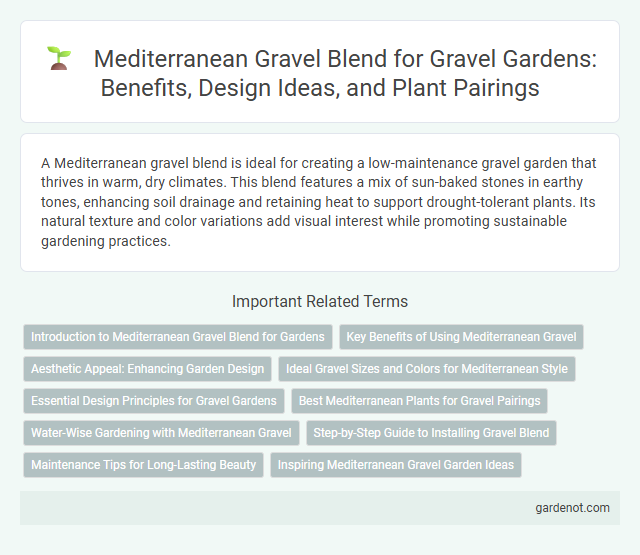A Mediterranean gravel blend is ideal for creating a low-maintenance gravel garden that thrives in warm, dry climates. This blend features a mix of sun-baked stones in earthy tones, enhancing soil drainage and retaining heat to support drought-tolerant plants. Its natural texture and color variations add visual interest while promoting sustainable gardening practices.
Introduction to Mediterranean Gravel Blend for Gardens
Mediterranean gravel blend is a popular choice for garden landscaping due to its natural durability and aesthetic appeal. Comprised of rounded pebbles and crushed stones in warm earthy tones, this blend enhances soil drainage and reduces weed growth. Its low-maintenance properties make it ideal for dry climates and water-efficient garden designs.
Key Benefits of Using Mediterranean Gravel
Mediterranean gravel offers excellent drainage, reducing water retention and preventing root rot in garden plants. Its natural, warm tones enhance landscape aesthetics, creating a serene and inviting environment. The durable composition withstands harsh weather conditions, ensuring long-lasting ground cover with minimal maintenance.
Aesthetic Appeal: Enhancing Garden Design
Mediterranean gravel blend elevates garden aesthetics by combining natural hues and textures that mimic coastal landscapes, creating a visually appealing and harmonious outdoor space. Its warm earth tones and varied pebble sizes add depth and contrast, complementing Mediterranean plants such as lavender, rosemary, and olive trees. This blend not only enhances the garden's design but also promotes a low-maintenance, drought-resistant environment perfect for sustainable landscaping.
Ideal Gravel Sizes and Colors for Mediterranean Style
Mediterranean gravel blends typically feature gravel sizes ranging from 10mm to 20mm, which provide excellent drainage and a natural, textured look ideal for Mediterranean gardens. Preferred colors include warm earth tones such as terracotta, sandy beige, and soft gray, reflecting the sun-baked hues of Mediterranean landscapes. Selecting a blend with varied pebble sizes and muted colors enhances both aesthetics and functionality, complementing drought-tolerant plants and stone pathways characteristic of Mediterranean garden design.
Essential Design Principles for Gravel Gardens
Mediterranean gravel blends are ideal for gravel gardens, combining crushed limestone and quartz to enhance drainage and reflect sunlight, promoting plant health. Essential design principles include selecting drought-tolerant Mediterranean plants such as lavender and rosemary, ensuring proper soil preparation with organic matter, and using gravel to create defined pathways that prevent soil erosion. Incorporating varying gravel sizes adds texture and visual interest while maintaining functional water permeability for sustainable garden maintenance.
Best Mediterranean Plants for Gravel Pairings
Best Mediterranean plants for gravel pairings include drought-tolerant species such as lavender, rosemary, and thyme, which thrive in well-drained, rocky soil. These plants complement Mediterranean gravel blends by enhancing water efficiency and providing aromatic foliage and vibrant blooms. Olive trees and succulents also adapt well to gravel gardens, adding structure and texture while requiring minimal maintenance.
Water-Wise Gardening with Mediterranean Gravel
Mediterranean gravel blends enhance water-wise gardening by improving soil drainage and reducing water evaporation, essential for drought-resistant landscapes. This gravel retains heat and reflects sunlight, creating a microclimate that supports Mediterranean plants like lavender, rosemary, and olive trees. Utilizing such gravel minimizes irrigation needs and promotes sustainable gardening in arid environments.
Step-by-Step Guide to Installing Gravel Blend
Prepare the area by clearing debris and leveling the soil to ensure proper drainage for the Mediterranean gravel blend. Lay a geotextile fabric to prevent weed growth and improve stability, then evenly spread the gravel blend, typically a mixture of limestone, terracotta, and shell fragments, to a depth of 2-3 inches. Compact the surface using a plate compactor or hand tamper to lock the stones in place, enhancing durability and maintaining the garden's aesthetic appeal.
Maintenance Tips for Long-Lasting Beauty
Mediterranean gravel blend requires regular maintenance to preserve its vibrant colors and prevent weed growth, including periodic raking and replenishing gravel layers every 1-2 years. Applying a weed barrier fabric underneath and using a natural herbicide can significantly reduce unwanted vegetation while minimizing chemical use. Proper drainage and occasional clearing of debris help maintain the gravel's aesthetic appeal and structural integrity over time.
Inspiring Mediterranean Gravel Garden Ideas
Mediterranean gravel blend enhances garden design with its natural, sun-baked tones and porous texture, promoting excellent drainage ideal for drought-resistant plants. Incorporating terracotta pots, lavender bushes, and olive trees complements the gravel's earthy palette, creating an authentic Mediterranean ambiance. Strategic placement of gravel pathways and seating areas maximizes both aesthetic appeal and functional outdoor living space.
Mediterranean gravel blend Infographic

 gardenot.com
gardenot.com